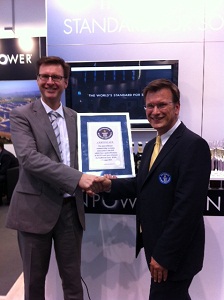SunPower gets the Guinness World Record for PV efficiency
 It may not be the most scientifically prestigious award, but the SunPower Corp.’s (NASDAQ: SPWRA, SPWRB) new E20 photovoltaic modules were awarded the Guinness Book of World Records Award for being the most efficient commercially available photovoltaic modules on the market. The company announced the new panels, which are over 20 percent efficient at converting sunlight into electricity, this week at the Intersolar conference in Germany.
It may not be the most scientifically prestigious award, but the SunPower Corp.’s (NASDAQ: SPWRA, SPWRB) new E20 photovoltaic modules were awarded the Guinness Book of World Records Award for being the most efficient commercially available photovoltaic modules on the market. The company announced the new panels, which are over 20 percent efficient at converting sunlight into electricity, this week at the Intersolar conference in Germany.
While Guinness isn’t the most scientifically respected journal, it is tirelessly and scrupulously researched.
“We got the certification from them [i.e., Guinness] on Monday, and made the announcement at Intersolar on Wednesday evening at our E20 launch event,” said SunPower spokesperson Ingrid Ekstrom. The panels are the first commercially-available photovoltaic modules to achieve total area efficiencies of 20 percent or more.
“The E20 panels are available for all markets—residential and commercial rooftops and ground-mount power plant applications,” Ekstrom said. The E20 solar panels have 96 cells and are available in 333-watt and 327-watt models for rooftop solar installations, the company said. “We will begin shipping in the third quarter 2011 to customers in Europe and Australia. Availability will be extended to North American and Asia in early 2012.”
The panels are also capable of operating at higher efficiencies of up to 5 percent more than rated. That’s thanks to the Maxeon solar cells that SunPower developed. The efficiency ratings were confirmed by National Renewable Energy Laboratory testing.
“The E20 panels utilize SunPower’s Maxeon cell, which offers 22.4 percent efficiency and is the most efficient solar cell available today in mass production,” Ekstrom said. “The 22.4 percent efficiency for the Maxeon cells is an average efficiency measure for the product. SunPower will continue to make incremental changes to our cell and panel technology to further enhance efficiencies where possible.”
The cells use back contacts to make the cells more efficient than other photovoltaics, which have electric contacts on their fronts, covering some of the photovoltaic material and thereby reducing their potential efficiency.
“With the Maxeon cells, we’ve increased the surface area by 4 percent to increase efficiency, which involved expanding from a 150 mm to a 160 mm cell diameter,” Ekstrom said. “The E20 panels also incorporate module design advances to increase module power and reliability.”
Features of the E20 panels include the Maxeon cell, anti-reflective glass and improvements in the panel materials.
“We’re expanding these features and benefits to our E18 and E19 panels this year,” Ekstrom said.



